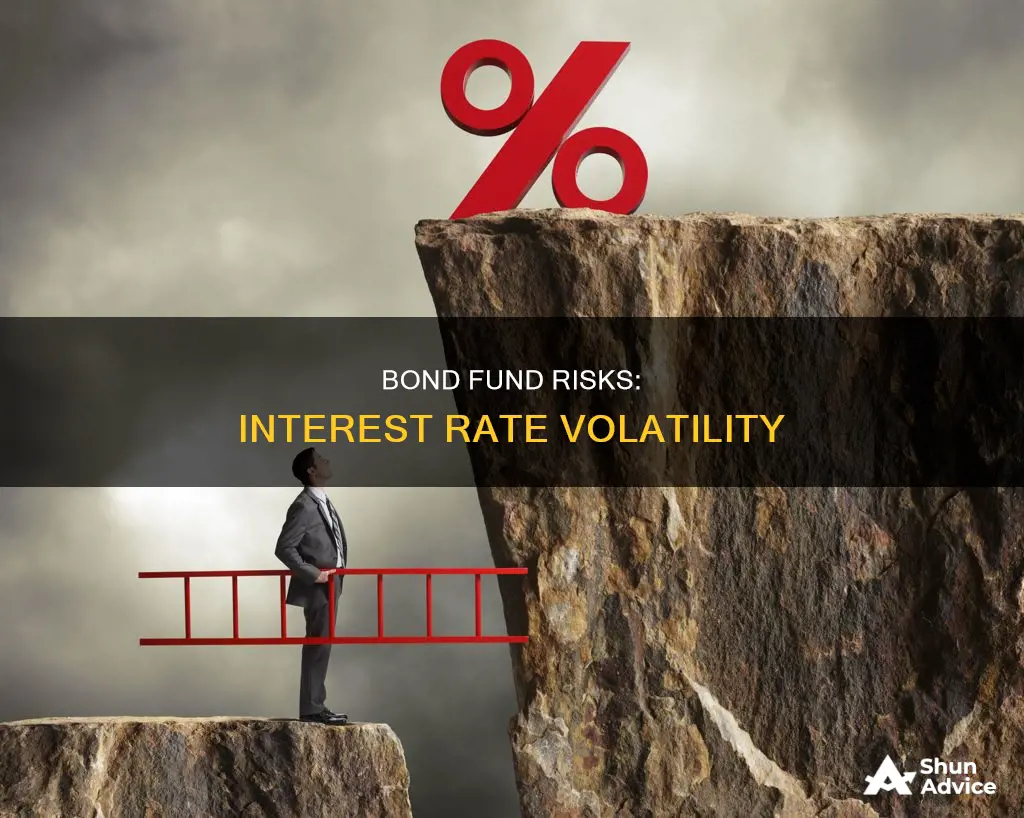
Investing in bond funds can be a great way to diversify your portfolio and generate income, but it's important to be aware of the potential risks. One significant risk is interest rate risk, where changes in market interest rates can cause fluctuations in bond prices. When interest rates rise, bond prices tend to fall, and vice versa. This is because newer bonds will be issued with more attractive rates, making older bonds less desirable. As a result, investors might sell their lower-yielding bonds, causing a decline in their market value. This interest rate risk is a major cause of price volatility in the bond market and can affect an investor's total returns. It's crucial for investors to understand this dynamic and carefully consider the potential impact on their bond fund investments.
| Characteristics | Values |
|---|---|
| Interest rate risk | When interest rates rise, bond prices fall, and the bonds that you currently hold can lose value. |
| Reinvestment risk | The risk of having to reinvest proceeds at a lower rate than what the funds were previously earning. |
| Credit/Default risk | The possibility that an issuer could default on its debt obligation. |
| Inflation risk | The risk that inflation will rise, thereby lowering the purchasing power of your income. |
| Liquidity risk | The risk that an investor might wish to sell a bond but is unable to find a buyer. |

Interest rate risk
The inverse relationship between interest rates and bond prices can be understood through supply and demand. When interest rates increase, the demand for existing bonds with lower interest rates decreases, leading to a drop in their market price. Conversely, when interest rates decline, investors seek to lock in higher rates, increasing the demand and market price of existing bonds.
Long-term bonds are more susceptible to interest rate risk than short-term bonds due to their longer duration and greater exposure to changes in interest rates. The impact of interest rate risk on bond prices is measured by "duration," which quantifies the sensitivity of a bond's price to changes in interest rates. For instance, a bond with a duration of 2.0 years will decrease in value by 2% for every 1% increase in interest rates.
To mitigate interest rate risk, investors can employ strategies such as diversifying their portfolios or using interest rate derivatives like forward contracts, interest rate swaps, and futures. These strategies help reduce the uncertainty associated with changing interest rates and protect against potential losses.
It's important for investors to closely monitor interest rate dynamics and consider the potential impact on their bond investments. While bonds are considered a stable investment option, interest rate risk is a key factor that can affect their value and overall returns.
Mutual Funds in India: Safe Investment or Risky Business?
You may want to see also

Reinvestment risk
Callable bonds are especially vulnerable to reinvestment risk. This is because they are typically redeemed when interest rates begin to fall. When the investor redeems the bonds, they will receive the face value, but will then have to reinvest at a lower rate of interest.
To compensate for this risk, investors receive a higher yield on the bond than they would on a similar bond that isn't callable. Active bond investors can also attempt to mitigate reinvestment risk in their portfolios by staggering the potential call dates of differing bonds. This limits the chance that many bonds will be called at once.
There are several methods to mitigate reinvestment risk, including the use of non-callable bonds, zero-coupon instruments, long-term securities, bond ladders, and actively managed bond funds.
Invest in Evolve Funds Group Inc ETF: A Beginner's Guide
You may want to see also

Default risk
Economic factors, such as recessions or downturns, can increase default risk as companies may struggle to generate sufficient revenue to meet their debt obligations. Company-specific factors, such as poor management, weak financial performance, and high levels of existing debt, can also elevate default risk. Market-related factors, including volatile interest rates and unstable political environments, can further heighten the risk of default. Therefore, assessing default risk requires a continuous analysis of both market conditions and the issuer's financial health.
Credit ratings provided by agencies like Fitch, Moody's, and Standard & Poor's play a crucial role in evaluating default risk. These ratings reflect the creditworthiness of bond issuers and their ability to honour their financial commitments. Higher credit ratings indicate lower default risk and are typically associated with lower interest rates, while lower credit ratings suggest higher default risk and higher interest rates to compensate investors for the increased risk.
To assess the financial health of a bond issuer, investors can analyse key financial metrics such as free cash flow, interest coverage ratio, and earnings before interest, taxes, depreciation, and amortization (EBITDA). A comprehensive assessment of default risk also involves monitoring market and economic conditions, including trends, economic cycles, and issuer-specific developments.
Crowdfunded Real Estate: Your Guide to Investing Wisely
You may want to see also

Inflation risk
To mitigate inflation risk, investors can consider investing in inflation-indexed bonds, which provide a fixed rate of return linked to the prevailing inflation rate, helping investors maintain their purchasing power. Another strategy is to diversify portfolios by investing in different asset classes, such as stocks, bonds, and cash, to balance the risks and take advantage of the upside potential of equities.
Additionally, investing in a mix of fixed-income assets, such as treasury bills, corporate bonds, and debt mutual funds, can provide a hedge against inflation risk and generate a steady income stream. Investing in assets with long-term maturities can also protect against inflationary pressures as they are less susceptible to short-term market volatility.
Bonds vs Mutual Funds: Where Should You Invest?
You may want to see also

Liquidity risk
Bonds vary in their liquidity, and investors who sell their bonds before maturity during a period of market stress may face decreased liquidity and potential investment losses. For example, rising interest rates can cause bond prices to fall, which may be accompanied by a bond market sell-off, further depressing prices. This can make it more challenging to sell a bond at a desirable price, especially for bonds with longer durations. Similarly, a credit scare in an industry sector or with a particular issue might have a dramatic impact on liquidity.
The bond market is structured differently from the stock market, which contributes to lower trading volumes. Most bonds are traded through dealers who buy and sell for their own accounts, while stocks are typically traded through brokerage firms that act as agents and deliver orders to an exchange or alternative trading system. The diverse characteristics of bonds, the large blocks in which they are traded, and the relative infrequency of trades also contribute to lower liquidity in the bond market.
Research by Friewald et al. (2012) found that liquidity can account for up to 30% of a corporate bond's yield during recessions and financial stress. Interestingly, AAA-rated bonds are better able to withstand financial stress and respond positively to illiquidity shocks, while higher-yielding, lower-rated corporate bonds perform poorly.
When considering liquidity in the bond market, investors should ask questions such as how their firm handles bond trades, the trading frequency of a particular security, the price range it has traded in, and how they can construct their bond portfolio to meet short-term and long-term liquidity needs.
Best TSP Funds: Where to Invest Your Money
You may want to see also
Frequently asked questions
Interest rate risk is the potential for a bond's value to fall in the secondary market due to competition from newer bonds with more attractive rates. This risk applies to bond funds as the securities held within them are subject to interest rate changes, which can affect the fund's performance.
Reinvestment risk is the possibility that the cash flow from a bond will need to be reinvested in new issues with lower yields. This can occur when interest rates fall and bond issuers exercise their right to redeem bonds early, leaving investors with a pile of cash that is difficult to reinvest at a comparable rate.
Default risk is the chance that the issuer of a bond will be unable to meet its financial obligations. This risk applies to bond funds as they are made up of multiple individual bonds, and the default of a single bond issuer within the fund can affect the overall fund value.
Inflation risk is the possibility that inflation will outpace the fixed income provided by a bond, resulting in a loss of purchasing power for the investor. This risk is particularly relevant for investors planning to live off their bond income but is a factor that all investors should consider.







